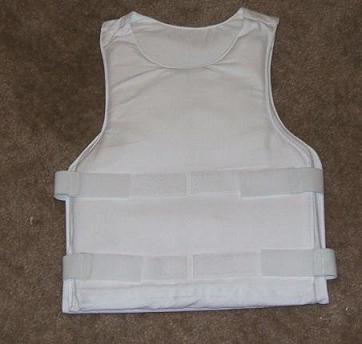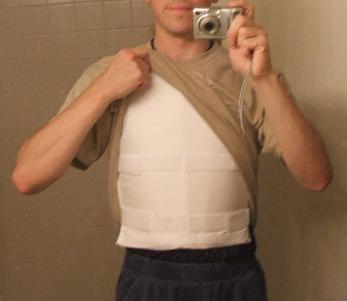*Buying Surplus Body Armor*
By: Penwu
18 May 2007
I think that among your average survivalists, body armor is a topic only vaguely understood and a tool unreasonably neglected. How many other ways are there to take a bullet to the chest and not need emergency medical aid? In a situation where someone is shooting at you, body armor is a huge ace-in-the-hole.
Consider it this way: do you have a contingency plan for a center-of-mass bullet wound?
Now, I don't see much day-to-day risk of being shot at...not enough to justify the discomfort of wearing body armor 24/7. But should I find myself in the midst of a civil or natural disaster...with crazy, desperate, and just plain malevolent folks running around...that armor is an option I want to have.
I don't have the $500 or $600 or more to drop on a new retail vest, though - body armor is not the only prep I need. What I can afford is a surplus police vest - about $200. Armor vests typically have a 5-year warranty, but that time period was chosen to limit liability, rather than for any reason related to the armor itself. Testing by the NIJ, among others, shows that Kevlar armor has no aging problems. So police agencies regularly are discarding perfectly good armor. But before I go too much further, let's look at a couple other issues.
Vest Material
Kevlar, Zylon, Goldflex, Spectra, Dyneema...akk! How does one figure out what's good and what's bad? Well, I encourage anyone planning to get armor to do all the research themselves to really understand things. But here's the basic situation as I understand it. The original, traditional Kevlar 129 fiber works great, except when it's soaking wet (but works fine again once it dries out). Vests made of 100% Kevlar are comparably heavy and stiff, though. So a handful of other materials have been devised to use along with Kevlar to reduce weight and increase flexibility while retaining ballistic protection.
The problem is, these other materials tend to degrade over time and with exposure to UV light. Zylon is the worst example - it seriously degrades, and all vests using it have been de-certified by the NIJ (details on the NIJ in a minute). Definitely DON'T buy a vest that uses Zylon. The others are better, but research appears to show that they do get weaker over time, and in particular are vulnerable to contact-range gunshots (due to the hot gases from the cartridge hitting the vest material).
So, my decision was to stick to only a pure Kevlar vest. Yes, it'll be a bit heavier than the newfangled exotic stuff - but I won't need to worry nearly so much about it weakening. That's particularly important to me because I'm getting a older vest.
Vest Protection Ratings
If you've looked into body armor at all, you've probably seen references to various "Levels" of armor. Those levels are the National Institute of Justice (NIJ) system of certifying what sort of bullets a given vest will protect against. In increasing order of strength, they are Level I, IIa, II, IIIa, III, and IV. Of those, Levels I-IIIa are soft armor to withstand pistol rounds, while Levels III and IV use hard steel or ceramic plates to protect against rifle rounds. You can see the comlete NIJ standards here (PDF), but the gist is:
Level I: .22LR, .25ACP, .32 ACP, .380ACP
Level IIa: Standard 9mm FMJ, standard .40S&W FMJ
Level II: 9mm +P FMJ, .357 Magnum JSP
Level IIIa: 9mm from a submachinegun, .44 Magnum SJHP
I don't expect to have to deal with military SMG ammo or .44 Magnums - the trifecta of standard fullsize pistols rounds (9mm, 40, 45) are far more common. So a Level II is what I decided to get. While not specifically rated for them, a Level II will also stop .45 ACP and 12 gauge buckshot.
BulletProofME.com
The vendor I used to buy my vest was BulletProofME.com. I chose a 100% Kevlar like-new Level II police surplus vests, and they took a bunch of measurements from me to ensure a good fit. I had the vest three business days after I placed my order. Their customer service was excellent, and the vest only cost me $195 shipped.

Things did get a bit questionable when I inspected the vest, though. They didn't exaggerate the condition - the vest looks like it's never been worn. The panels, however, gave me some hesitation. They were certified by the State of California rather than the NIJ, and the vest was originally a Level IIa, constructed of two panels stitched together in the front and back. BulletproofME added a third panel to reach a Level II rating based on their in-house testing. The result is 24 layers of Kevlar, which is slightly more than a Level II vest usually has, but the final product has not been certified as Level II by any lab or agency.
After doing some research on the California armor testing standards, I am confident that this vest will do just what BPM.com claims - there's nothing magical about Kevlar armor, despite all the paranoia of liability lawyers. I would have liked to know all the details of the vest up front, though.
Wearability
"Concealable" armor really is concealable. It's rather like when you first start wearing a well-concealed gun. Nobody can see it, but you can feel it, and it sure seems like it must be totally obvious to everyone around you. I expected that I would need a moderately heavy shirt to really hide my vest, but was surprised to find that even a pretty light t-shirt will do the job just fine:


Now you see it...and now you don't.
I was also pleasently surprised by the flexibility afforded by the vest. If feels rather stiff and clunky at first, but the shoulder and neck cuts are deep enough that it really doesn't restrict movement at all. I can touch my toes and arch my back into a "bridge" without trouble with the vest on.
This vest isn't something I'll be wearing to work every day, but it is definitely a piece of emergency gear that I'm glad to have. If I ever have to make a bug-out trip through a bad situation, body armor will definitely give me some more peace of mind. I think it's something everyone ought to consider as well.
Penwu
www.alpharubicon.com
All materials at this site not otherwise credited are Copyright © 1996 - 2007 Trip Williams. All rights reserved. May be reproduced for personal use only. Use of any material contained herein is subject to stated terms or written permission.


